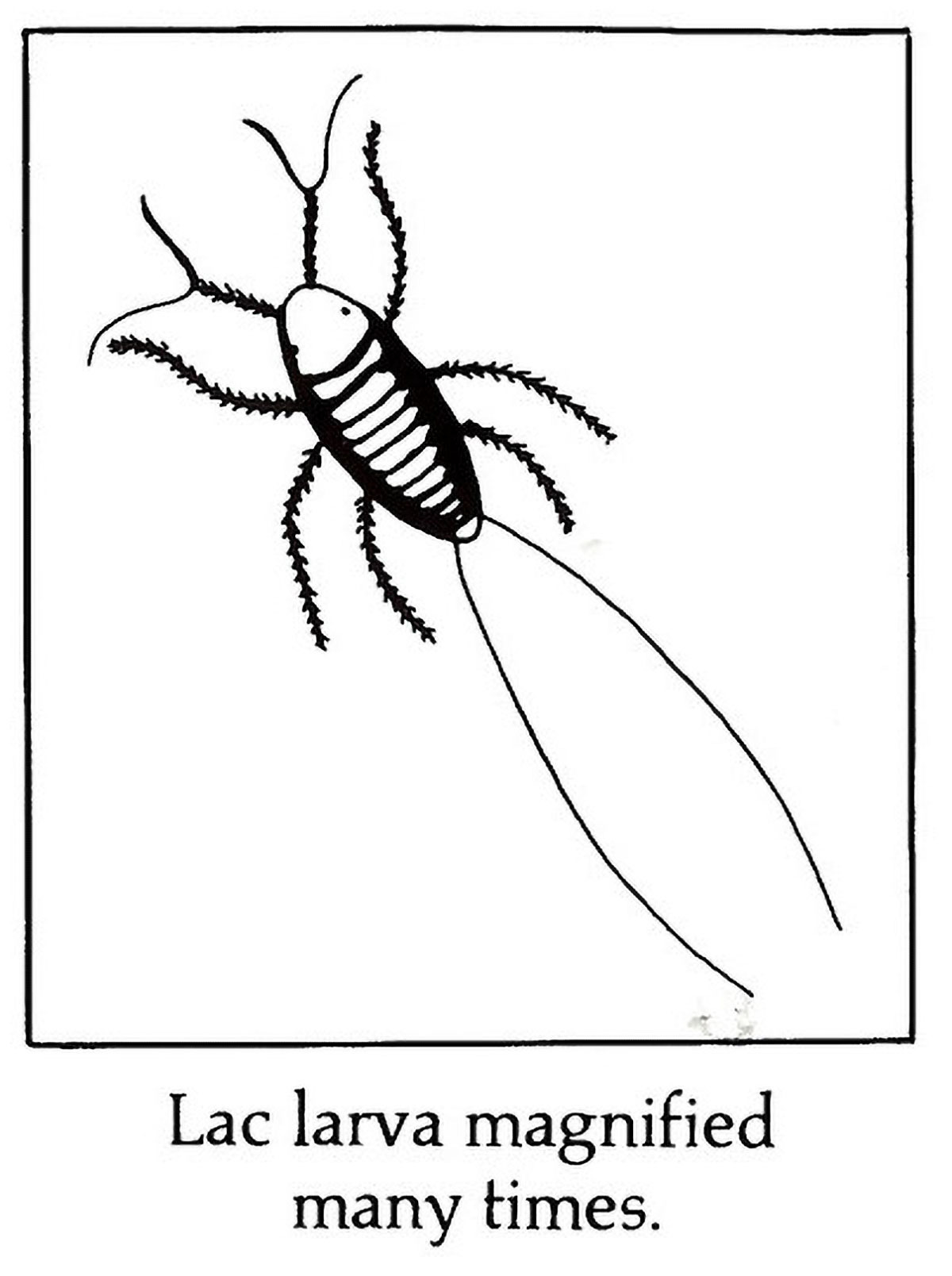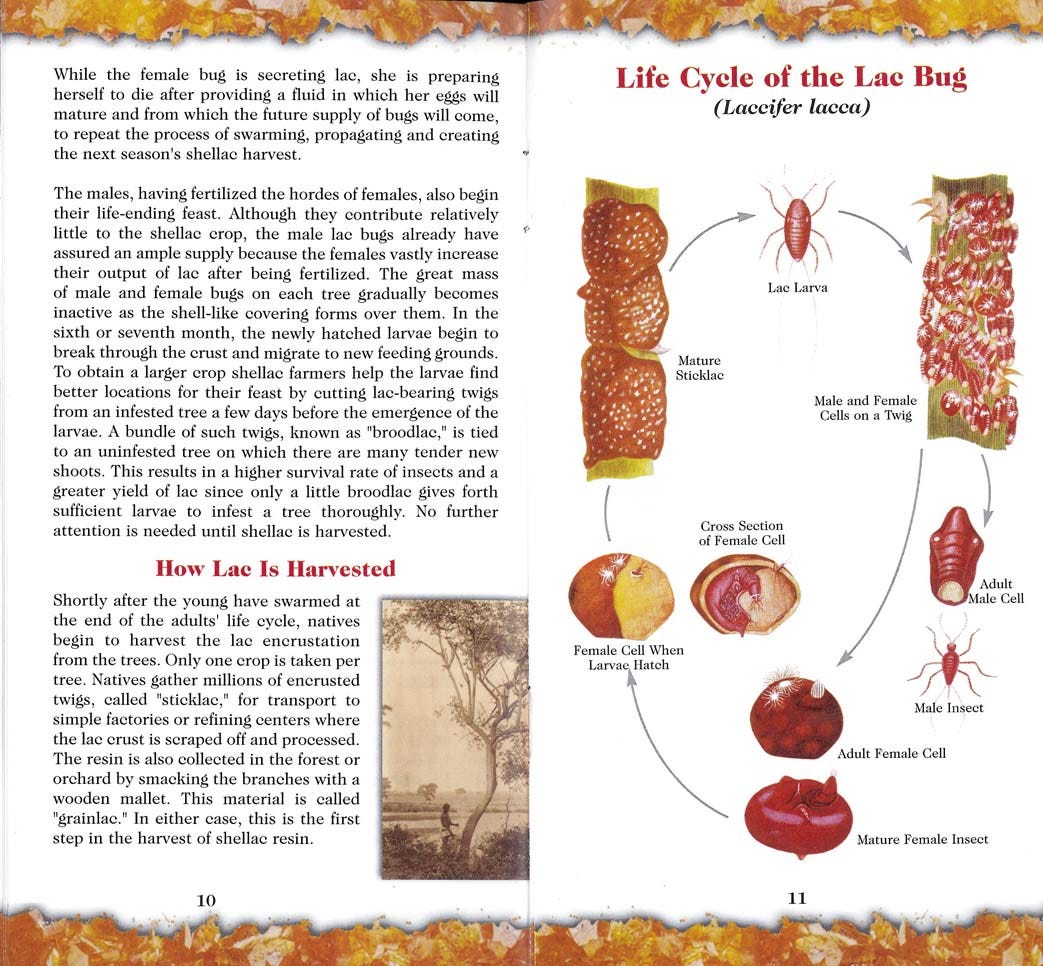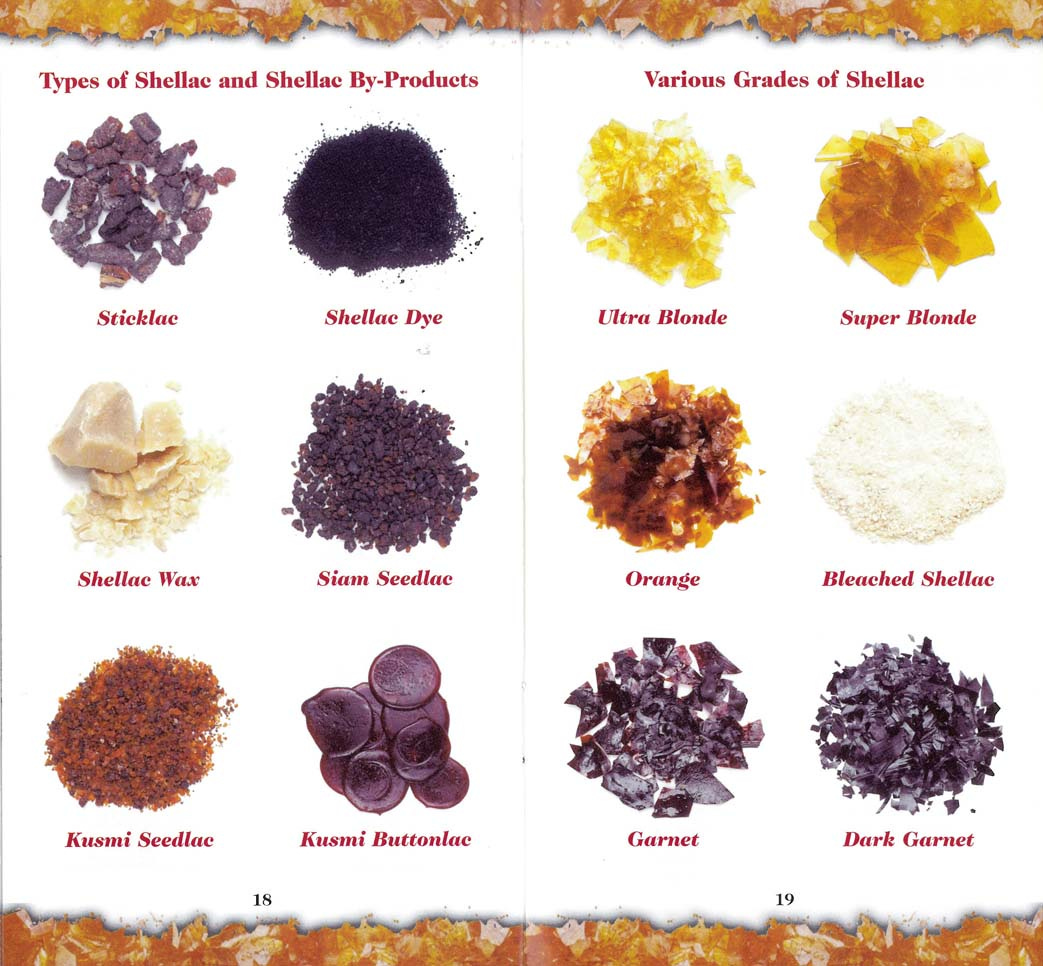The State of Shellac
Some experts are ringing alarm bells. But the truth might be that nearly all agricultural products are volatile.
What follows is one of the deep research pieces that Kara Gebhart Uhl specializes in. We can afford to produce these articles thanks to paid subscribers. This month, Kara looks into the world of shellac. We were trying to find out if there was any truth to a published account that made it sound like shellac was in crisis.
The answer, of course, is far more nuanced than a short blurb or video can convey. By the time you finish this article, you’ll have enough perspective on the shellac industry to decide for yourself.
As for me, my conclusion and recommendation is this: Use shellac.
— Christopher Schwarz
Last year, we watched a fascinating short video on how shellac is made, produced by Business Insider. However, some comments gave us pause.
“… fluctuating harvests and prices have put this ancient industry at risk.”
and
“… raising the storied insects has gotten a lot harder, largely due to the climate crisis. Intensifying rainstorms have washed lac off tree branches and led to fungal infestations. More extreme heat is drying up the trees that are the insect’s main food source.”
And then there are the headlines and research related to global insect decline in general:
from The Guardian: “‘Half the tree of life: ecologists’ horror as nature reserves are emptied of insects”
and
from Current Opinion in Environmental Sustainability: “Insect decline, an emerging global environmental risk”
and
from Biological Conservation: “Worldwide decline of the entomofauna: A review of its drivers”
So, we wondered: Is shellac in trouble? We talked to experts across several shellac-related industries to help us – and you – understand the shellac economy.
What is Shellac?
Shellac is a resin produced by lac insects. These tiny insects swarm host plants then pierce and suck plant sap from these host plants. After the sap is digested, it’s secreted through the lac insect’s pores. While eating the sap, the lac insects propagate. The secreted sap eventually becomes a hard covering that protects the swarm of lac insects and their eggs.
Branches encrusted with the secreted sap, called sticklac, can be cut and harvested. Shellac farmers often cut encrusted twigs before the larvae hatch, bundling them together to form a broodlac. The broodlac is then tied to a new host plant, which the hatched larvae then infest. The cycle then begins anew.
It takes about 100,000 lac insects to make about 1 pound of shellac.
Once the hard resin is scraped off the branches, it goes through a production process where it’s crushed, washed and dried, and any small sticks, stones or other such debris are removed. The lac is stuffed into a cloth tube, which is spun through a kiln. The lac melts, and from there it can be formed into small buttons (which, if you’ve purchased shellac before, you may know as button shellac). The melted shellac can also be formed into sheets. Once cooled, these sheets are stretched and chopped into smaller pieces (which you may know as shellac flakes).
The History of Shellac
In 2004, in celebration of its 155th year of manufacturing shellac, Zinsser revised a booklet called “The Story of Shellac,” first published in 1913. Another interesting read: “Shellac: A Story of Yesterday, Today and Tomorrow” by Elizabeth Brownell Crandall, published in 1924. And, this chapter from “The Butterfly Effect: Insects and the Making of the Modern World” by Edward D. Melillo.
Shellac has been used for thousands of years, as a dye, resin and in medicine. Shellac first made its way to Europe in the late 13th century.
From Zinsser’s booklet: “By the mid-17th century shellac resin, shellac dye and shellac wax were used with increasing frequency by painters not only to create their masterpieces, but also to provide them with a protective finish. Shellac became the preferred finish for craftsmen and artisans; it was the coating of choice for fine furniture, woodcarvings and turnings. To this day some of the finest museum pieces still have their original shellac finish.”
In the mid-19th century, bleached shellac, also called white, clear or colorless shellac, became popular.
From Zinsser’s booklet: “As far back as the 1830s shellac chemists discovered that by chlorinating an alkaline solution of shellac, they could remove almost all of the color and then precipitate the resin. The result was a pale, straw-colored varnish that excelled any oil-base varnish for clarity.
“By the middle of the 19th century, Germany was the center of shellac bleaching for all of Europe. One such bleachery, located in the town of Mainz, employed a man named William Zinsser as one of its bleaching foremen. Confident of his technological skills and convinced that a good market for bleached shellac either existed or could be created in the United States, Zinsser and his family emigrated to America.”
Zinsser’s prediction of a good market in America proved to be true.
U.S. manufacturers found myriad ways to use shellac: as a binder in records; as a coating on pills, fruit, nuts and candy; as a sealer for plaster walls; as a varnish for interior woodwork; and in many other things, such as hair spray, adhesives, grinding wheels, electrical insulators, printing ink, shoe polish, men’s hats and foil coatings.
How the Lac Insect is Faring Today
Dr. K.K. Sharma, who has studied the lac insect for more than 30 years, is currently the project coordinator of the Network Project on Conservation of Lac Insect Genetic Resources, and is the former director of ICAR – National Institute of Secondary Agriculture, formerly the Indiana Institute of Natural Resins and Gums; Indian Lac Research Institute.
As of today, 101 species of lac insects have been reported from all over the world, Dr. Sharma says. There are two categories of lac insects. There’s the pseudo lac insect, whose product isn’t commercially usable. Then there are true lac insects, which produce lac of commercial importance.
“Among all insects, Kerria lacca, Kerria chinensis and Kerria sharda are the most exploited insects for production of lac,” he says.
The majority of lac is cultivated in Thailand and India, with Thailand contributing about 30 percent of the world demand, and production fluctuations sometimes bringing instability, Dr. Sharma says. Lac is also cultivated in China and Myanmar.
In India, lac is cultivated in Central and Eastern India.
“Jharkhand and Chhattisgarh are leading states in lac production contributing about 80 percent of national production (about 60 percent of world lac production),” Dr. Sharma says. “Remaining quantity comes from adjoining states like Madhya Pradesh, Maharashtra, West Bengal and two North Eastern states Assam and Meghalaya. It is estimated that about 400,000-500,000 families are engaged in lac cultivation.”
Dr. Sharma says lac farming requires plant hosts.
“Lac farmers never cut these trees which are regular source of income to them,” he says. “There are scores of insect biota associated with the lac insect (predators, parasites, hyperparasitoids, etc.). Some of them are species-specific. If we lose lac insects, there is likelihood of losing these associated insects.”
Over the years, Dr. Sharma has witnessed changes in production and commercialization.
“The major change we brought is bringing lac from forest to agriculture,” he says. “Earlier lac used to be collected from forests now it is being cultivated using scientific methods. This has brought stability in production. Minor changes are reported in production due to climatic factors. However, it is around 5 to 10 percent only of total lac production. Regarding commercialization, many new products and processes have developed that has created regular demand of lac domestically and elsewhere.”
Dr. Sharma notes that many species of lac insects are endangered, including those reported from non-lac-growing areas where lac is no longer cultivated. In terms of biodiversity, these endangered lac insect species are of concern.
“But production-wise, it is almost stable for the last decade or so because of scientific lac farming,” he says.
I asked Dr. Sharma if woodworkers should expect a decline in the availability of shellac in the future.
“It is a vicious cycle,” he says. “If there is no demand or overproduction, prices crash and farmers tend to abandon lac cultivation. If a consistent demand can be ensured, lac will always be available. Lac has survived vagaries of business over 5,000 years and will continue to be available always.”
The most important thing we can do is to assure steady demand, he says.
“The industry has failed miserably in this aspect,” Dr. Sharma says. “Lac marketing is a closed one with supplier to consumer chain. We have to bring transparency in its trade. Producers, processors and consumers need to come at one platform for open and frank discussion that is lacking.”
8 More Perspectives
We spoke with researchers, importers, wholesalers and users of shellac to get a sense of how they’ve observed the market changing (or not) in recent years.
Ron Ashby, owner of Wood Finish Supply & Shellac.net
Ashby has been in the shellac business for 50 years (and is looking to sell his company, in case you’re interested). He serves as a distributor and technical service representative for several finish brands. For more than 40 years, he’s worked with the same third-generation shellac supplier in India.
Ashby sells seedlac, button shellac, waxy shellac and dewaxed shellac. He includes detailed information about how these shellacs are processed on his site.
“It’s an agricultural product, just like grapes, here, or corn in the Midwest,” he says. “There are years when it’s good and years when it’s bad.”
Typical customers in the shellac industry include specialty finishing companies, schools, conservators, restorers, museums, custom furniture makers, leather companies, the hat industry, and the stone and marble industry.
For Ashby, the biggest problem is transport – the cost of moving shellac around the U.S. Because shellac is heat sensitive, Ashby transports all of it by plane – he doesn’t want it sitting on a ship for a long time. A year and a half ago, shipping a 55-pound bag from Napa, California, (where Shellac.net is based) to Chicago by UPS was $40. Today, it’s $65.
The U.S. recently added an additional 25-percent tariff on many Indian goods. When I asked Ashby about the tariffs, he said it’s all up in the air right now. In this political climate, tariffs continue to be instituted, reversed and thrown out. You also have to look at the fine print, he says – they typically only affect certain industries, certain-sized packages, that sort of thing. What he does see are companies buying smaller quantities more frequently and not stocking up, waiting for the economy to settle.
Joel Moskowitz, owner of Tools for Working Wood
Joel Moskowitz imports shellac directly from India, as well as from Germany, where he gets refined Tiger flakes from a large shellac importer. Moskowitz says Tools for Working Wood is the largest importer and wholesaler of flake shellac sold in this country, supplying companies such as Woodcraft and Lee Valley.
“The shellac crop in the past decade or so has failed repeatedly, probably due to climate change,” he says. “As India gets richer, there are fewer people willing to stay in the shellac business.”
While Moskowitz says he doesn’t know anything directly about the lac beetle supply, he says these issues are real and prices have increased substantially in the past 15 years.
“But a good crop brings them down,” he says.
Shantanu Shukla, assistant professor, Development Biology and Genetics, Indian Institute of Science
Shantanu Shukla is one of the authors of a June 2025 study published in the Proceedings of the National Academy of Sciences that interestingly found that a yeast-like organism that lives inside the lac insect is responsible for the red pigment secreted from the lac insect.
When I reached out to Shukla, he noted that he’s not a professional lac farmer nor has he done any systematic studies on the population dynamics of the lac insect. Still, he’s well familiar with the species.
The Kerria lacca, Kerria chinensis and Kerria yunnanensis are the most widely used species in the production of shellac flakes, he says.
“My impression is that there has been a population decline since historical times due to loss of habitat, and that only a few species are now being reared as of today,” he says. “However, since the last few decades, the populations have appeared stable.”
Keep reading with a 7-day free trial
Subscribe to The American Peasant to keep reading this post and get 7 days of free access to the full post archives.







